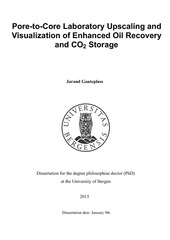| dc.contributor.author | Gauteplass, Jarand | eng |
| dc.date.accessioned | 2015-02-11T09:17:42Z | |
| dc.date.available | 2015-02-11T09:17:42Z | |
| dc.date.issued | 2015-01-09 | eng |
| dc.identifier.isbn | 978-82-308-2741-3 | en_US |
| dc.identifier.uri | https://hdl.handle.net/1956/9370 | |
| dc.description.abstract | The global energy demand increases, and the need for hydrocarbon reserve growth is evident. The maturation of hydrocarbon formations worldwide combined with declining rate of major oil and gas discoveries, have caused a renewed focus on implementing enhanced oil recovery (EOR) methods in hydrocarbon reservoirs. The success of an EOR project relies on identifying the key driving forces. Non-invasive, non-perturbing imaging of fluid dynamics in laboratory opaque systems can identify recovery mechanisms beyond material balance experiments. Furthermore, flow experiments should be conducted at a variety of scales in the laboratory to couple small-scale phenomena and basic mechanisms to the complexity of fluid flow in the field. This thesis visualizes and identifies EOR mechanisms from pore- to core-scale in order to improve fluid flow characterization in porous media. A novel imaging approach is presented in Paper 1 where positron emission tomography (PET) to image fluid flow was combined with structural information acquired from computed tomography (CT). Superimposed images described how rock discontinuities affected labeled water fronts and overall sweep efficiency. Paper 2 is an extension of Paper 1 and involves explicit tracking of the gas phase and evaluates the synergy between EOR and permanent CO2 storage. Molecular diffusion and viscous displacement were identified as recovery mechanisms in respectively fractured sandstone and tight shale. Furthermore, a large fraction of injected CO2 was effectively retained in the pores by capillary forces, demonstrating the potential for safe CO2 sequestration. Explicit flow information during waterfloods and CO2 injection for EOR and storage was successfully used to evaluate size dependence on developed flow patterns. The pore-to-core scale approach was experimentally verified in Paper 3, where similar displacement systems were studied at the pore-scale. Capillary and dissolution trapping of CO2 by water were directly observed in etched-silicon micromodels. CO2 was trapped in single pores and in larger clusters, and the residual phase was poorly connected throughout the network. In pore-level observation of CO2 EOR, high recoveries were observed due to a spreading oil layer between the water phase and the non-wetting gas phase. Building on Paper 1-3, it was evident that CO2 injection for EOR in fractured systems needed to be improved. Therefore, Paper 4 evaluates mobility control in fractures. Co-injection of gas and surfactant solution was compared to wateralternating- gas (WAG) and continuous gas injection (CGI), and was the preferred method in terms of areal sweep and mobility reduction factor in 2D fracture networks as a result of foam generation. Foam generation was studied at the pore-scale in Paper 5, where rectilinear snap-off and snap-off at permeability discontinuities were identified as important lamella creation mechanisms. Low salinity waterflooding (LSW) was evaluated in Paper 6 as an alternative to gas injection in oil-wet carbonates. Wettability alteration and interfacial tension reduction between crude oil and water were effects attributed to LSW, resulting in enhanced secondary and tertiary oil recovery at reservoir conditions. Osmotic pressure was discarded as a dominant LSW mechanism in corefloods based on pore-level observations. | en_US |
| dc.language.iso | eng | eng |
| dc.publisher | The University of Bergen | en_US |
| dc.relation.haspart | Paper I: Fernø, M.A., Gauteplass, J., Hauge, L.P., Abell, G.E., Adamsen T.C. & Graue, A.: “Quantitative Visualization of CO2 Storage and Oil Recovery Using Positron Emission and X-ray Computed Tomography”. Full text not available in BORA. | en_US |
| dc.relation.haspart | Paper II: Fernø, M.A., Hauge, L.P., Gauteplass, J., Abell, G.E., Adamsen T.C. & Graue, A.: “Explicit CO2 Flow Characterization in Unconventional Formations”. Full text not available in BORA. | en_US |
| dc.relation.haspart | Paper III: Gauteplass, J., Follesø, H.N., Graue, A., Kovscek, A.R. & Fernø, M.A: “Visualization of Pore-level Displacement Mechanisms during CO2 Injection and EOR Processes”, proceedings at EAGE IOR 2013: From Fundamental Science to Deployment, Saint Petersburg, Russia, 16-18 April 2013. Full text not available in BORA due to publisher restrictions. The article is available at: <a href="http://dx.doi.org/10.3997/2214-4609.20142617" target="blank">http://dx.doi.org/10.3997/2214-4609.20142617</a>. | en_US |
| dc.relation.haspart | Paper IV: Fernø, M.A., Gauteplass, J., Pancharoen, M., Haugen, Å., Graue, A., Kovscek, A.R. & Hirasaki, G.: “Experimental Study of Foam Generation, Sweep Efficiency and Flow in a Fracture Network”, SPE 170840, proceedings at SPE Annual Technical Conference and Exhibition, Amsterdam, The Netherlands, 27–29 Oct. 2014. Full text not available in BORA due to publisher restrictions. The article is available at: <a href="http://dx.doi.org/10.2118/170840-MS" target="blank">http://dx.doi.org/10.2118/170840-MS</a>. | en_US |
| dc.relation.haspart | Paper V: Gauteplass, J., Chaudhary, K., Kovscek, A.R. & Fernø, M.A.: “Pore-level Foam Generation and Flow for Mobility Control in Fractured Systems”. Colloids and Surfaces A: Physicochemical and Engineering Aspects 2015; 468: 184-192. The article is available at: <a href="http://hdl.handle.net/1956/9371" target="blank">http://hdl.handle.net/1956/9371</a>. | en_US |
| dc.relation.haspart | Paper VI: Gauteplass, J., Leon, I.D., Markey F.J., Fernø, M.A., Graue, A., Barati, R.: “Low Salinity Waterflooding in Carbonates: Improved Oil Recovery and Relative Permeability Effects”. Full text not available in BORA. | en_US |
| dc.title | Pore-to-Core Laboratory Upscaling and Visualization of Enhanced Oil Recovery and CO2 Storage | en_US |
| dc.type | Doctoral thesis | |
| dc.rights.holder | Copyright the author. All rights reserved | en_US |
| dc.identifier.cristin | 1178298 | |
